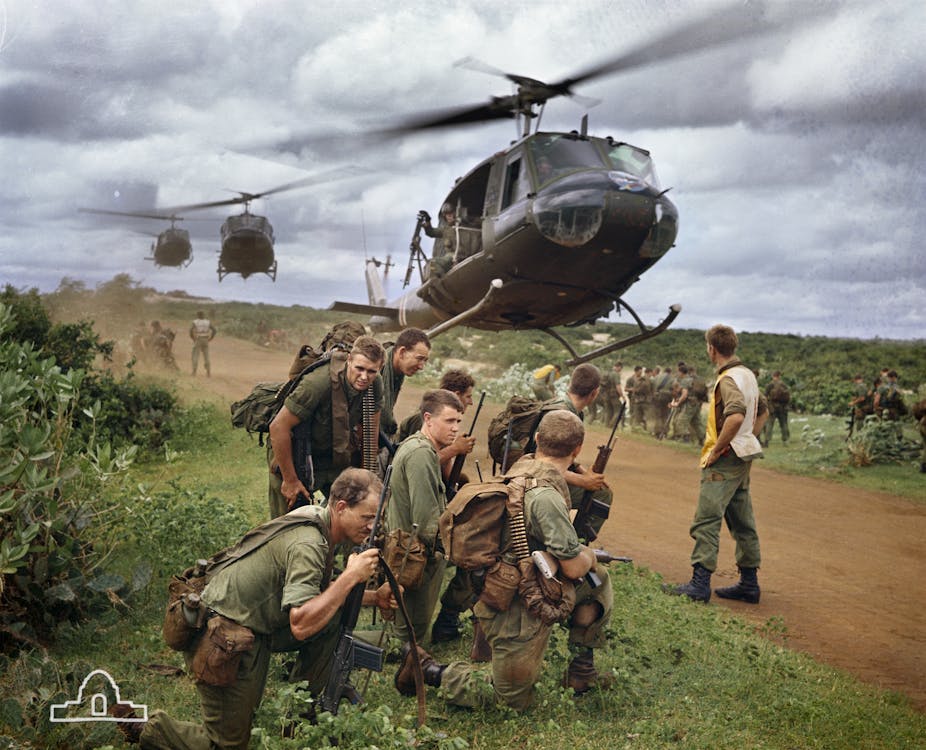An unprecedented level of media coverage made the Vietnam war a watershed moment in the discipline of photography.
The images by official military photographers, photojournalists, and individual soldiers provide a complex record of the war. But what is obscured in this record is often as telling as what is included.

A single moment captured in a photograph only tells part of the story. As these several examples of the conflict illustrate, a photograph, when plucked from the events that surround it, can be interpreted in various ways. In the Vietnam war, the subject and how it was represented depended greatly on who was taking the photograph and why.

The mission of the official army photographers was to build public support for the Australian forces in Vietnam. Often in these images, the photographer was trying to personalise the war for Australians at home and make it familiar.

The captions for the photographs taken by Army Public Relations photographers Michael Coleridge and Christopher Bellis, for example, often included the name and home town of the soldiers depicted. This increased their usefulness for Australian local newspapers but also brought the experience of those fighting closer to home.
This official record, however, is also notable for its absences.
For example, Bellis’s confronting photographs of the aftermath of an ambush at Thua Tich were suppressed by the army at the time, as were Coleridge’s images of Australian soldiers burning village huts to prevent their use by the Viet Cong (see image below).

Vietnam, a counter-insurgency war with no fixed front lines, saw the emergence of a correspondingly decentralised media presence. While army photographers’ work was being closely controlled, civilian journalists had unprecedented freedom of movement and access to combat units.

For example, news photographer Denis Gibbons who worked for Fairfax press and United Press International, photographed the same bloody Thua Tich ambush site. But in his case, the images were released into the public domain without any controls.
This freedom often meant that the relationship between photojournalists and soldiers was a delicate one.
Many soldiers, aware of how photographs were influencing public perceptions of the war, were wary of any media presence.

The issue that concerned these soldiers goes to the heart of what makes Vietnam War photography truly significant. Removed from its context, a photograph can be appropriated and re-framed, perhaps to serve an agenda very different from anything the photographer may have envisaged.

Take, for example, the series photographed by Gabriel Carpay of To Thi Nau, a Viet Cong prisoner being interrogated by Australian soldiers in October 1966. Journalists were only present for a short period of this session; that they were present at all is evidence of the journalists’ freedom to move around in Vietnam relatively unhindered.
Seventeen months later an exaggerated account was published which asserted that Australian soldiers had forced water down the prisoner’s throat for around 30 minutes. The resulting controversy evolved, with Carpay’s photographs eventually being cited as “proof” in subsequent allegations that the use of torture by Australian soldiers was not uncommon, even though, on Carpay’s own admission, very little about the actual interrogation can be gleaned from his images.

The use of photographs to record or suppress events, or to support or contest a claim, is nothing new, but in Vietnam the unprecedented degree of coverage of this politically divisive war brought these issues into sharp relief.
The photographs in this article were kindly provided by the Australian War Memorial.
Last week marked the 50th anniversary of Australian forces arriving in Vietnam. The Conversation has looked at the war’s legacy throughout a number of articles over this week.
Part 1: Forgetting the ‘American War’: Vietnam’s friendship with its former enemy
Part 2: Vietnam and Iraq: lessons to be learned about mental health and war
Part 3: Stabilising the Middle East: lessons from the US rapprochement with China

